OUR BURNING PLANET 168
Quest for elusive white shark decades ago raises questions about the species today
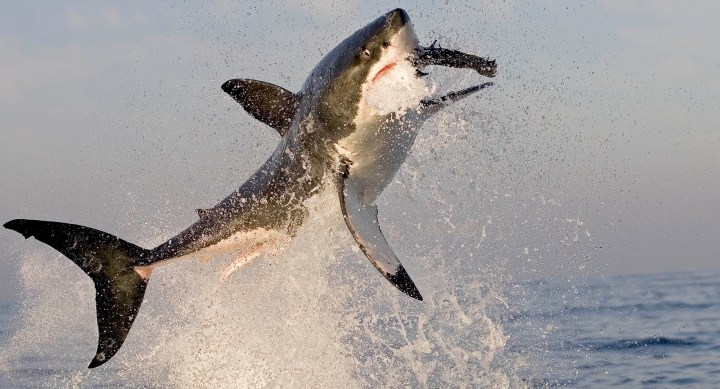
It is 50 years since the publication of the book Blue Meridian: The Search for the Great White Shark by famed natural history writer Peter Matthiessen. The book chronicled the making of the film Blue Water, White Death, which also hit the screens in 1971. Fifty years later, the book and the film raise fascinating questions about the species today. With the benefit of hindsight, it seems perplexing that the crew made its first attempt to find white sharks by following whaling vessels off Durban instead of heading straight to the Cape. But, as the species’ recent disappearance from False Bay suggests, white sharks are never permanent residents.
First published in the Daily Maverick 168 weekly newspaper.
In April 1969, the Terrier VIII, a former whaling ship, set sail from Cape Town, destined for Durban. Table Mountain would have loomed in the background, perhaps shrouded in mist. The Terrier’s ultimate quest was also obscured, shrouded in the mist of marine myths and the unknowns of the deep blue.
The vessel had been chartered by a US film crew with a single-minded ambition: to do a cage dive with, and capture on film, the elusive great white shark.
It was a thrilling endeavour, mixing extreme sport with a voyage of discovery. In that sense, it captured the prevailing zeitgeist. Months later, a human would set foot on the moon for the first time. It would take until the following year for the filmmakers to finally have their face-to-face encounter with the great white, half a world away, off the coast of Australia.
The saga of the expedition was vividly captured in a book published in 1971, Blue Meridian: The Search for the Great White Shark. The author was the American Peter Matthiessen, a one-time CIA operative widely regarded as one of the greatest natural history writers of his era.
In the closing credits of the famed 1971 documentary film about the odyssey, Blue Water, White Death, Matthiessen is listed as “expedition historian”. Fifty years on, the project raises fascinating questions for anyone with an interest in the social and natural histories of the great white, or white shark in the parlance of our times.
One starting point is the Terrier’s departure beneath the hulking figure of Table Mountain. After pulling out of Cape Town as the austral autumn was setting in, the ship – manned, according to Matthiessen’s account, by Norwegian officers and a crew comprised of mostly Cape coloured people – would have set off on a southeasterly course. That would have taken it past places such as Gansbaai, a picturesque coastal village.
More than three decades later, in 2001, I did a cage dive in Gansbaai, an unforgettable experience that brought me face to face with a white shark. By then, a cage-diving industry was flourishing and well established there.
I had read Blue Meridian for the first time shortly beforehand, and was struck at the time by an obvious question: why the hell hadn’t the expedition started in Gansbaai?
Why did the Terrier, after passing within miles, if not right over, prime white shark territory, forge ahead until it rounded the southern tip of Africa, only to press on in a jaggedly northeasterly course from the frigid Atlantic into the warm, subtropical embrace of South Africa’s Indian Ocean coast? We’ll come back to this shortly.
The reason for the Terrier’s destination lay in the vessel’s former role: South Africa’s whaling industry. And Durban was its main port of call.
The expedition’s leaders reckoned the best chance of finding the great white was to be had by following the last of South Africa’s whaling vessels from Durban to their killing zones, where sperm whales were still harpooned in a clinically industrial manner, if not quite the industrial scale that the slaughter had once obtained. And indeed, sharks by the score would be attracted to the carcasses of the slain whales, and caught in memorable footage by the underwater videographers who made Blue Water, White Death a bone-chilling ode to Neptune’s realm.
But most were oceanic white-tipped reef sharks. They would not catch sight of a single white shark, and so the project would move on, the Terrier following its northeastern trajectory to Sri Lanka, before it headed back to Africa, with attempts off the Comoro Islands and Mozambique.
Finally, the film crew made a last-ditch attempt at the aptly named “Dangerous Reef” off Australia, where the species was finally filmed by divers in – and out of – a protective cage.
This was under the guidance of Rodney Fox, a famed Australian diver who invented the first cages for shark diving and had previously made shark documentaries with Rod and Valerie Taylor, who were also involved in Blue Water, White Death.
A champion spear fisherman, Fox survived a savaging by a white shark in 1963, not far from Adelaide. A subsequent trip to the zoo would inspire the idea for a cage from which to observe white sharks. Fox wanted to get back into the water, but he didn’t want to be exposed to another attack.
“I was in the Adelaide Zoo and we were looking at the lions in the cage and there was a moat around it. I wondered why the moat – it was to keep the humans from reaching their arms in. And I thought they were man-eaters and I saw the water. So I reversed the role and built a cage for humans,” Fox, who was 80 at the time, told me in a phone interview from his South Australian base. He is a surviving member of the Blue Meridian narrative’s final Australian stage.
Matthiessen makes it clear in the book that the expedition did not have an endless pot of cash or investors who could be chummed. Like almost all films, it had a budget, and that must have been stretched to the limit.
This brings me back to the question raised above: why on Earth would you start a search for great whites in South African waters and not begin in the cold waters of the Cape, where we now know they often occur in significant numbers, and where an entire ecotourism industry has been built around their presence?
“From Durban, we know now they needed to turn right instead of going straight,” Fox told me.
There can only be two, possibly related, explanations for this. One is that the species’ existence in the Cape waters was not common public knowledge like it is today. The other is that the species is not always present there, or at least not in relative abundance.
Then, recently, the white sharks seemed to vanish into thin air. In 2017, white shark sightings in the Cape hot spots of False Bay and Gansbaai declined steeply. No white sharks were seen at all in 2019, and one was finally sighted in False Bay in January 2020 – the first one seen there in 20 months.
A number of possible reasons have been given, including predation by orcas, which seem to have a fondness for sharks’ livers.
And that got me thinking: could that have been the state of play when Blue Meridian was being written and Blue Water, White Death was being filmed? Could the Terrier, on its passage to Durban from Cape Town, have passed by or through waters where the predator was largely absent at that time?
If that is the case, then this is a classic example of “changing baseline syndrome” – our propensity to regard the natural world encountered in our lifetime as the norm.
The 2017 to 2020 decline and vanishing act may not be unusual events – it is possible the species has also been scarce at times in False Bay and Gansbaai before. Indeed, there is data that I will discuss below that suggests that this is indeed the case.
It’s also possible that the Cape waters were effectively devoid of the species in the public mind in the late 1960s, even if they teemed with white sharks. Either way, it underscores a wider point: our dearth of knowledge about white sharks, and marine species and ecosystems more generally.
“I’ve been working in this field since 1998 and it’s still only a snapshot of their lives, as they can reach up to 75 years in age and we tend to forget that. From … personal experience I feel like I have dedicated almost half of my life to trying to understand them. But, on the other side, that is only a small part of their lives,” Alison Kock, a marine biologist and shark expert with South African National Parks, told me. “We still don’t fully understand the distributional ranges of these sharks and the drivers behind them.”
Scant science
If that is the case today, imagine the state of play in the 1960s. The members of the 1969 expedition were generally guided by the prevailing knowledge at that time regarding white sharks. This was not extensive.
Fox told me that after his attack he was looking for information on his attacker, but could only find “three or four books on game fishing, with horrible pictures of sharks that had been caught and they looked ugly and horrible and they had no underwater photographs of sharks”.
Still, there was some information available. On some matters Matthiessen, the expedition’s scribbler, had clearly done his homework, while also making some dubious assertions. And even with the benefit of hindsight, the expedition made some questionable decisions.
In the book, Matthiessen writes that Stan Waterman, one of the film’s cinematographers, “had never seen a white shark underwater, but last summer one came up and nudged his skiff in the Gulf of Maine… In 1953, off Cape Breton Island, a lobsterman drowned when a white shark foundered his dory; his companion clung to the wreckage and survived. White shark attacks upon small boats have occurred regularly in the Maine-Nova Scotia region, and apparently the fish is noted for this tendency wherever it is found.”
That intrigued this correspondent, who happens to hail from Nova Scotia.
And the 1953 incident off Cape Breton did, in fact, take place. It is recorded in a 2017 Fisheries and Oceans Canada report on white sharks in Atlantic Canada.
The report includes an appendix of the historical record of white shark sightings and catches in Atlantic Canada from the early 1870s to 2016.
Published in the same year that white shark sightings in the Cape waters fell dramatically, the report came out against a backdrop of growing interest in and monitoring of the species’ presence in Nova Scotian waters. It is also noted in the Global Shark Attack File (GSAF), a project of the Shark Research Institute.
The attack Matthiessen refers to took place on 9 July 1953, off Fourchu, Cape Breton. “Teeth in attacked dory; dory attacked and sunk,” says the brief description of the event. But the historical record does not support the writer’s comment that white shark attacks on small boats were common in such waters.
The 1953 Cape Breton sinking by a torpedo with teeth was the last recorded shark attack in eastern Canadian waters until August this year, when a 21-year-old woman was airlifted to hospital after an apparent savaging by a shark. Before the 1953 incident, there are only three others noted sporadically over the preceding 80 years – in the early 1870s, in 1920 and in 1932.
But Matthiessen’s assertion that the big fish has a “tendency” to attack small boats is borne out by the GSAF, which mentions many such incidents over the years in Australian and South African waters. We shall return below to this database, which stretches back to antiquity.
Thar she blows
The decision to follow whaling vessels was not far-fetched, even if it failed. On 4 March this year, South Carolina fisherman Chip Michalove witnessed a dead northern right whale being ripped to shreds by great whites, telling The Atlantic that he had never beheld such a feeding frenzy before.
But no great whites would be lured by the dead leviathans harpooned off Durban while the Blue Water, White Death crew was filming. Rodney Fox’s son Andrew, who, along with his father, operates a diving company catering to tourists in Australia, told me in a telephone interview that it seemed the whalers may have confused oceanic white-tipped sharks with great whites.
“Before Blue Water, White Death, Dad had already done a couple of films with Ron Taylor on great white sharks. They did one or two variants… [Filmmaker] Peter Gimbel had a million-dollar budget and he had the vision to make a documentary. He heard these stories about white sharks stripping whales down to the bone and they confused white-tip oceanic sharks with great white sharks. But nobody really knew where they were and what they did. They were exploring and pioneering,” the younger Fox told me.
The bloody feeding scenes featuring hordes of white-tipped sharks made for graphic footage five decades ago, but that was not the point of the expedition. They wanted a great white.
And there were tantalising clues about white sharks in the colder Cape waters, but the expedition did not rise to the bait.
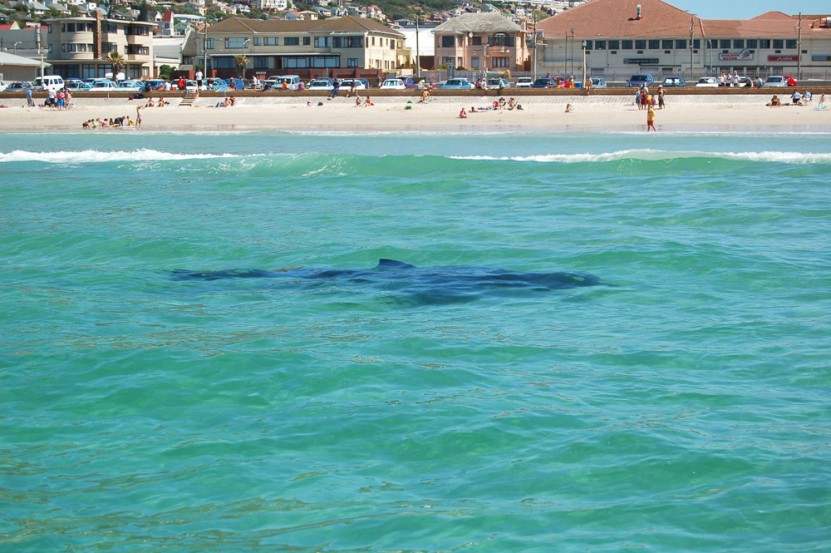
A white shark cruises off Fish Hoek beach, in Cape Town’s False Bay. This photo was taken by the Shark Spotters research team while trying to tag great white sharks along the inshore areas of False Bay in 2006 to learn more about their inshore patterns of behaviour. The team has published several papers on this behaviour now. Picture: © Alison Kock.
An Englishman named Basil Livingstone, the owner of a small fleet of vessels including the Terrier, appears in the narrative of Blue Meridian. Inspecting the shark cages on the foredeck of the Terrier, he declared them to be “flimsy”, based on his own experience with white sharks. Matthiessen writes that Livingstone claimed to have caught white sharks in Saldanha Bay on South Africa’s Atlantic coast, north of Cape Town.
Then there is the jarring opinion of the unnamed coloured contingent of the Terrier’s crew, as well as that of those who manned the W-29, the whaling vessel the filmmakers and writer trailed.
“The crew officers are Norwegian, the crewmen mostly Cape [coloureds]… The whalemen among them are fascinated by the search for the great white shark. Like the crew of the W-29, they claim they have never seen it in these latitudes, though it occurs farther south in the cold waters off the Cape of Good Hope,” Matthiessen wrote. (Italics added.)
Matthiessen goes on to write: “The opinion of the crewmen must be taken seriously since they have seen thousands of sharks, though whether they have looked at them is another matter: when closely questioned, they admit that they have never seen the white shark at all, in cold waters or warm.”
So the expedition had anecdotal evidence of great whites in the vicinity of the Cape. And the crew members fessed up that they had never actually seen one.
Still, their claims that they were found in the cold Cape waters were intriguing in hindsight. What were the grounds for such a view, even one that proved uncertain? Matthiessen does not seem to have pressed them on that issue.
More telling perhaps is the South African media coverage of the expedition. Matthiessen writes that there was plenty of that, not all of it flattering. “There was a press conference at quayside, complete with three models who moved as a trio, expressionless and inseparable as baby fish, and the papers the next morning were full of silly stories about New York millionaires seeking white death in local waters.”
He noted that the stories “curled the [greying] hair” of filmmaker Peter Gimbel. Unnamed publicity people kept feeding the local press updates of the filming.
What is striking about this state of affairs is that no one in the local media appears to have questioned why the filmmakers were not going to the Cape in the first place.
Matthiessen makes no mention of anyone from the media pointing this out. This suggests that the local media, and the wider South African public, were broadly unaware of a significant white shark population around the Cape.
How was that possible in 1969, given what we might think we know now? (This correspondent has tried without success to get access to newspaper archives that could shed light on the local media coverage at the time. When and if I do, I plan a follow-up to this piece with these missing pieces to the puzzle.)
The GSAF database – which is incomplete, it must be said – offers some clues.
In the 1950s, it only records four confirmed incidents involving white sharks in all of what is now the Western Cape province, and only two in False Bay.
Then, suddenly, in 1960, there is a spate of incidents. In April 1960, a white shark reportedly rammed a ski boat in Saldanha Bay. In the month of October alone, there are three, one in Saldanha Bay and two in False Bay, all involving white sharks ramming boats – underscoring Matthiessen’s assertion that the species was known for this type of apparently aggressive behaviour.
In June 1962, a white shark slams into another boat in False Bay. For the remainder of the decade, there are only three recorded white shark encounters in Western Cape waters. One was on the Garden Route, well east of the False Bay/Gansbaai area, though also in a region that would become known for white shark diving.
The other two would both take place in False Bay, one near the Strand, when a white shark holed a boat. The occupants of the boat were said to be “shark watching”. The next occurrence came in 1964 in Muizenberg, when a man had his right ankle lacerated by a 1.5m white shark.
So for all of the 1960s, there are only eight white shark attacks or episodes recorded by the GSAF in Western Cape waters, the last one in 1964. In KwaZulu-Natal waters, there are half a dozen white shark attacks recorded in the 1960s, two of which were fatal and so presumably they would have made more of a media splash.
That suggests there was some knowledge of white shark populations in South African waters, but physical encounters involving boats or people – the kind noted in the GSAF – and the species remained scattered. In the last half of the 1960s, there were none of this nature reported in the Western Cape at all.
In Australia, for all of the 1960s, there are 13 recorded attacks by white sharks on boats or people, including the 1963 incident that almost cost Rodney Fox his life. That is also not a lot, but there was certainly evidence pointing to Australia’s south coast as a possibility, which indeed turned out to be the case.
The decision to go to Sri Lanka and the Comoros seems to have been completely misguided. There are no incidents involving the species in the waters of either country at all in the 1960s in the GSAF. They also tried a couple of dives off the northern Mozambique coast.
But the expedition can hardly be faulted for its failure to go to the Cape waters where the Terrier had originated. White shark incidents at the time were apparently relatively rare then, at least according to the records compiled by the GSAF.
Sort of like what unfolded perhaps between 2017 and 2020 in False Bay and Gansbaai.
Rise of the wet suit
Another intriguing point about the GSAF database is that in the 1950s and 1960s, only four of the reported Western Cape white shark incidents involved attacks directly on people, and none of them was fatal. At least one was a spear fisherman, another was “diving for sinkers”.
But in the 1970s, there were no fewer than 10 incidents in Western Cape waters involving direct physical interactions between Homo sapiens and white sharks.
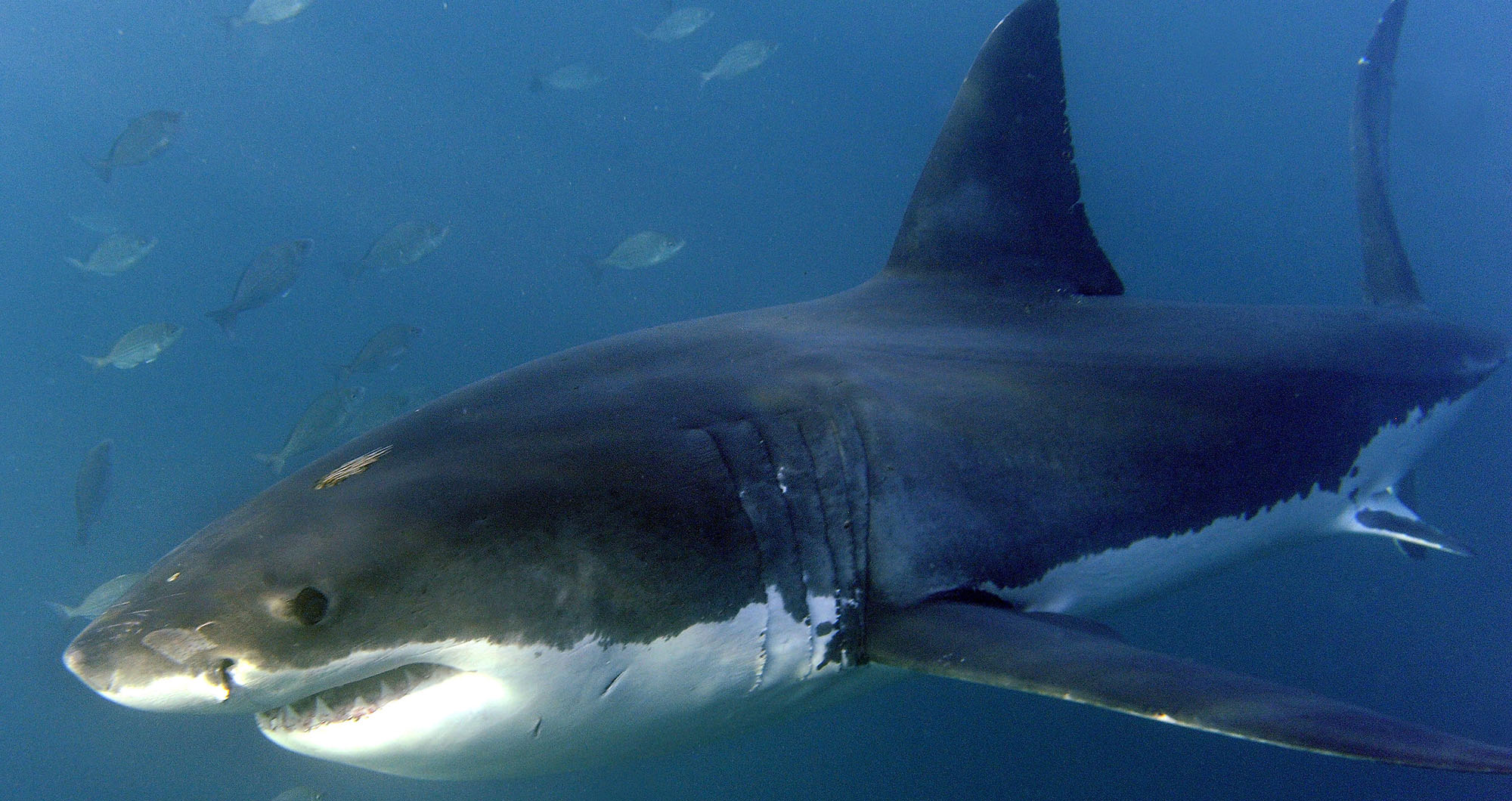
A Great White shark (Carcharodon carcharias) is seen in Gansbaai, South Africa. (Photo: EPA/HELMUT FOHRINGER)
The humans were surfing, spear fishing or swimming. And in November 1976 at Clifton Beach in Cape Town, 19-year-old Geoffrey Spence was bitten in the torso. He was thrashing in the water while imitating a victim from the movie Jaws – a case of life imitating art.
This apparent surge in white shark attacks on humans in the frigid Cape waters may be explained by the rise of the wet suit.
“Most of the shark information in South Africa before 1990 came from the Natal Sharks Board and they were not located in the Cape. In the Cape, where the water is very cold, swimming and surfing only became popular with the advent of wet suits on a commercial scale in the 1970s,” Kock said.
That would explain the relative dearth of incidents before the 1970s between humans and white sharks in Western Cape waters. (Many scientists are now pushing to have direct encounters between humans and sharks rebranded as “interactions” or “bites”. This may look like an example of “wokeness” but it is driven by the fact that humans are not typically on the menu of sharks and that they are not believed to always bite humans out of aggression or predatory instincts. This writer remains comfortable using the term “attack”, but it seems to be falling out of scientific favour.)
The 1970s also saw a rise of white shark fishing – the popularity of Jaws probably played a role here – and that seems to have spawned some of the incidents recorded along the Western Cape coast over the course of that decade.
In 1974 alone, a shark fisherman named Danie Schoeman was entangled in three hair-raising incidents with white sharks noted in the GSAF. His boat was holed twice that year and once a white shark leapt into his boat and bit a chair.
Kock also notes that in 1991, white sharks became a protected species, “after which shark fishermen started turning to shark tourism, and so the rise of shark tourism took place in the early 1990s”.
Along with this came increased scientific monitoring and public awareness of the populations – a level of scrutiny that had not been obtained before.
This would shape our current “baseline” – the perception that because white sharks almost always seemed to occur in False Bay and nearby Cape waters in the 1990s and 2000s, this was the natural or normal state of affairs.
But as the recent disappearance of white sharks from False Bay and other Cape waters, and the experience of the film crew chronicled by Blue Meridian suggest, the sharks seem to come and go.
“The disappearance from False Bay and Gansbaai has not been mirrored in Mossel Bay or Algoa Bay,” Kock said. “And, in fact, we are now getting even more sightings of white sharks along the KwaZulu-Natal coastline than we ever have before.
“Why they use these different areas in different years is possibly related to environmental conditions, the availability of prey and their life stage. At different life stages they have different nutritional needs. So you might find them moving from one spot to another spot as they mature, based on what they need at that stage of their lives.”
Elsewhere, white sharks appear to be returning – or increasing in numbers – around another Cape, namely Cape Cod on America’s northeast coast. Or perhaps this is just the perspective informed by our baseline. Rising seal numbers and a more than two-decade ban on fishing or hunting the big sharks have been among the reasons given for the species’ growing presence in waters off the New England tourist mecca. That has raised alarms about the dangers to human swimmers and surfers in the area.
Further north up the coast in July last year, the state of Maine recorded its first-ever incident of a human being killed by a shark. In 2018, 26-year-old Arthur Medici was killed by a shark while boogie boarding at a Cape Cod beach – the first fatal shark attack on a human at Cape Cod in more than 80 years.
Australia or bust
The Blue Water, White Death cast and crew did finally get their shark off Australia’s Dangerous Reef – but without the Terrier, replaced by the Saori for the exhibition’s last attempt.
Matthiessen writes that the logistics on the water “were the province” of Rodney Fox.
Dangerous Reef lies in the Spencer Gulf, and Matthiessen would write that the Australian divers on the Saori “think that Spencer Gulf is the best place in the world to film the great white shark, which is drawn inshore by sea lions”.
This raises the obvious question: why did the expedition not go there in the first place? Be that as it may, this final destination would finally yield the creature they had begun their quest for, off of Durban. The crew was almost at their wits’ end when a voice, according to Matthiessen, yelled “Shark!” down the companionway.
There were a pair of white sharks – the larger one a heavy male about 4m in length, attracted by copious amounts of bait and chum. And they did not act like the sharks filmed off Durban. This was a different kettle of fish.
“The sharks off Durban … probed the cages and scraped past,” Matthiessen writes, “but never once, in hundreds of encounters, did one attack them open-mouthed. The white sharks were to attack the cages over and over.”
Thousands of miles to the west, had the expedition missed a golden opportunity while in South Africa to film the species in the Terrier’s home waters of the Cape?
Perhaps they had, and perhaps they hadn’t. That point remains a mystery, as elusive as the white shark almost proved to be for the underwater pioneers behind a marvellous book and film that appeared 50 years ago. Half a century later, there remain many white shark mysteries for scientists to unravel.
“We still have so many unanswered questions,” the shark scientist Kock told me. DM168
This story first appeared in our weekly Daily Maverick 168 newspaper which is available for R25 at Pick n Pay, Exclusive Books and airport bookstores. For your nearest stockist, please click here.




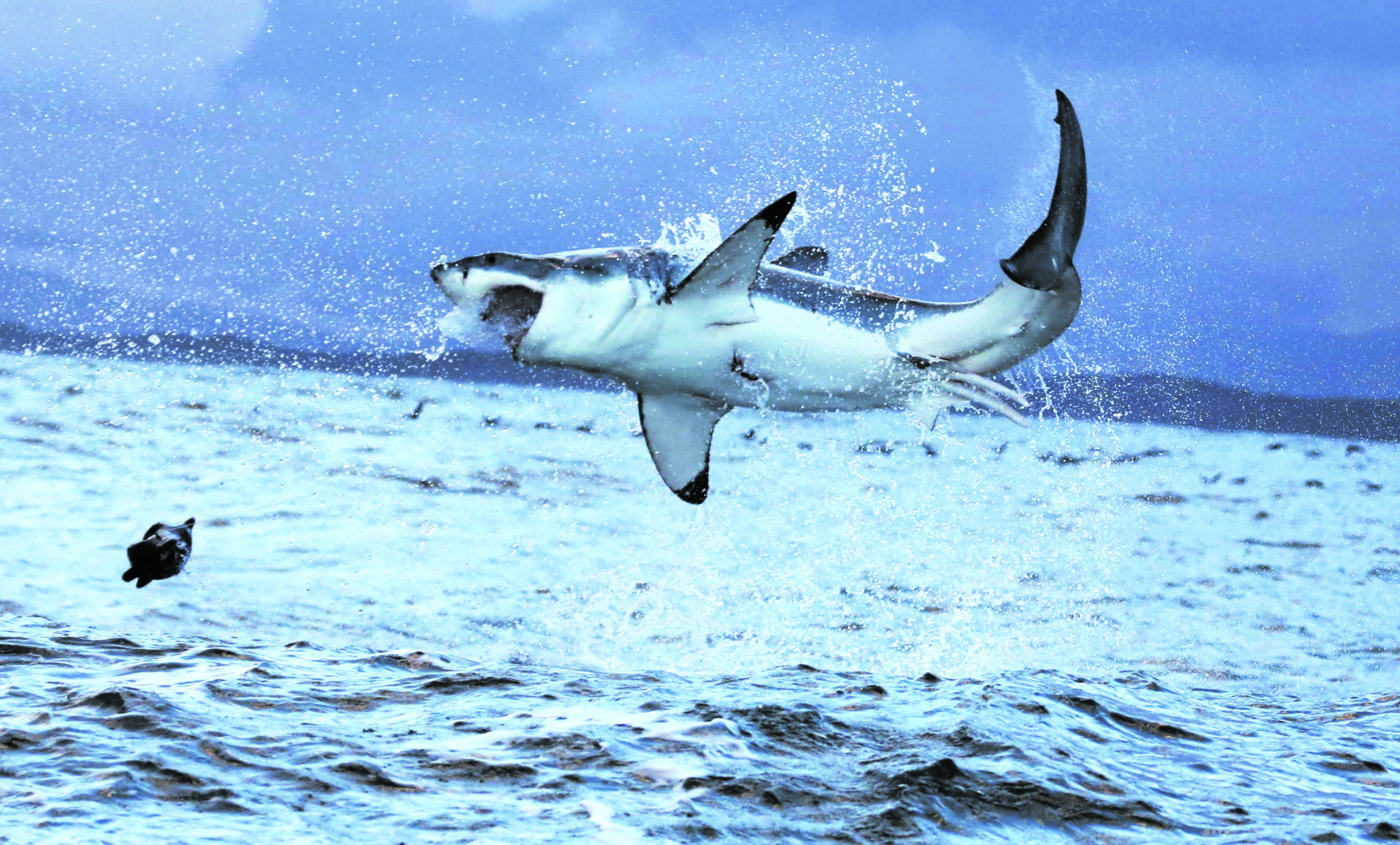
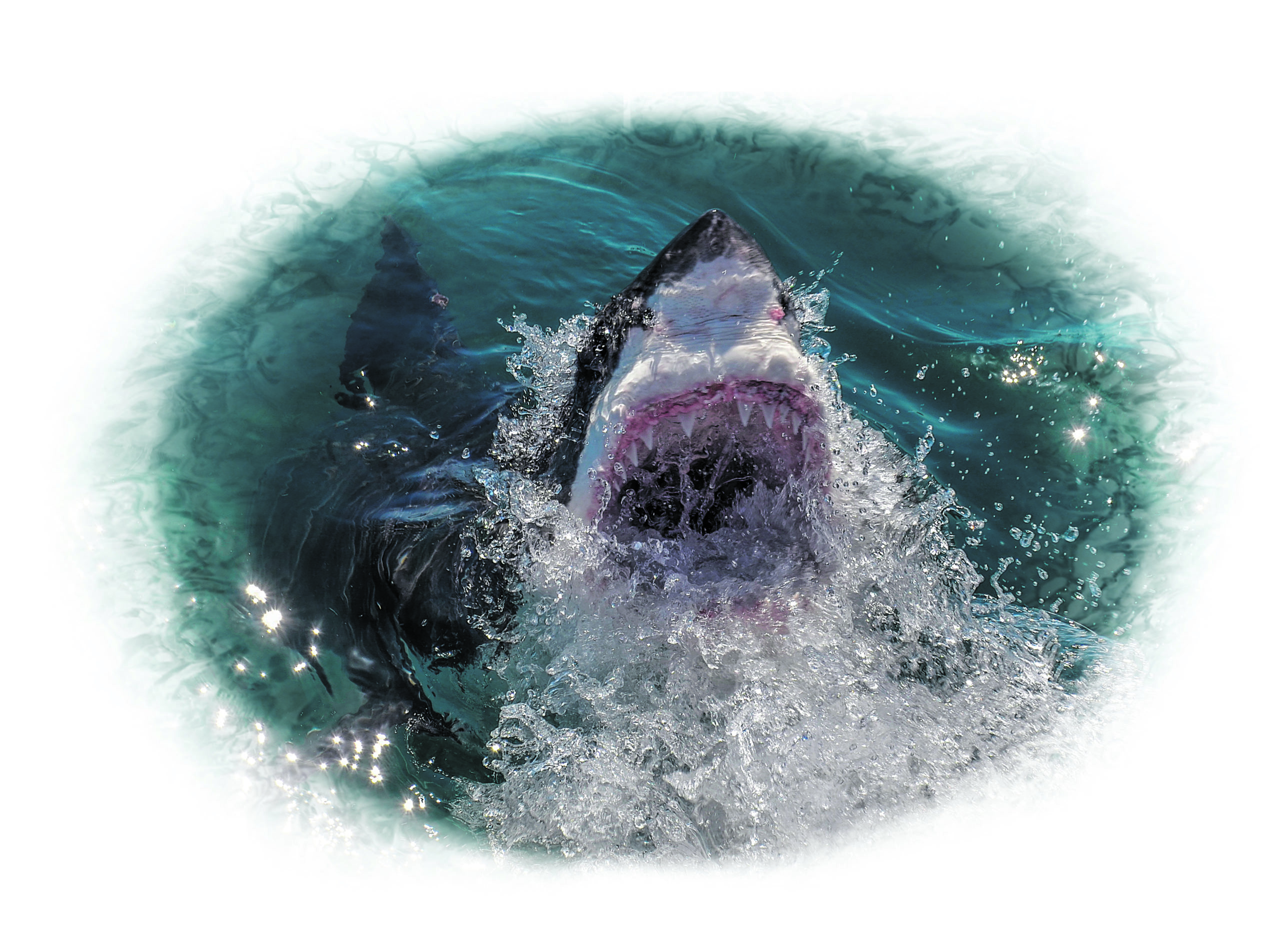
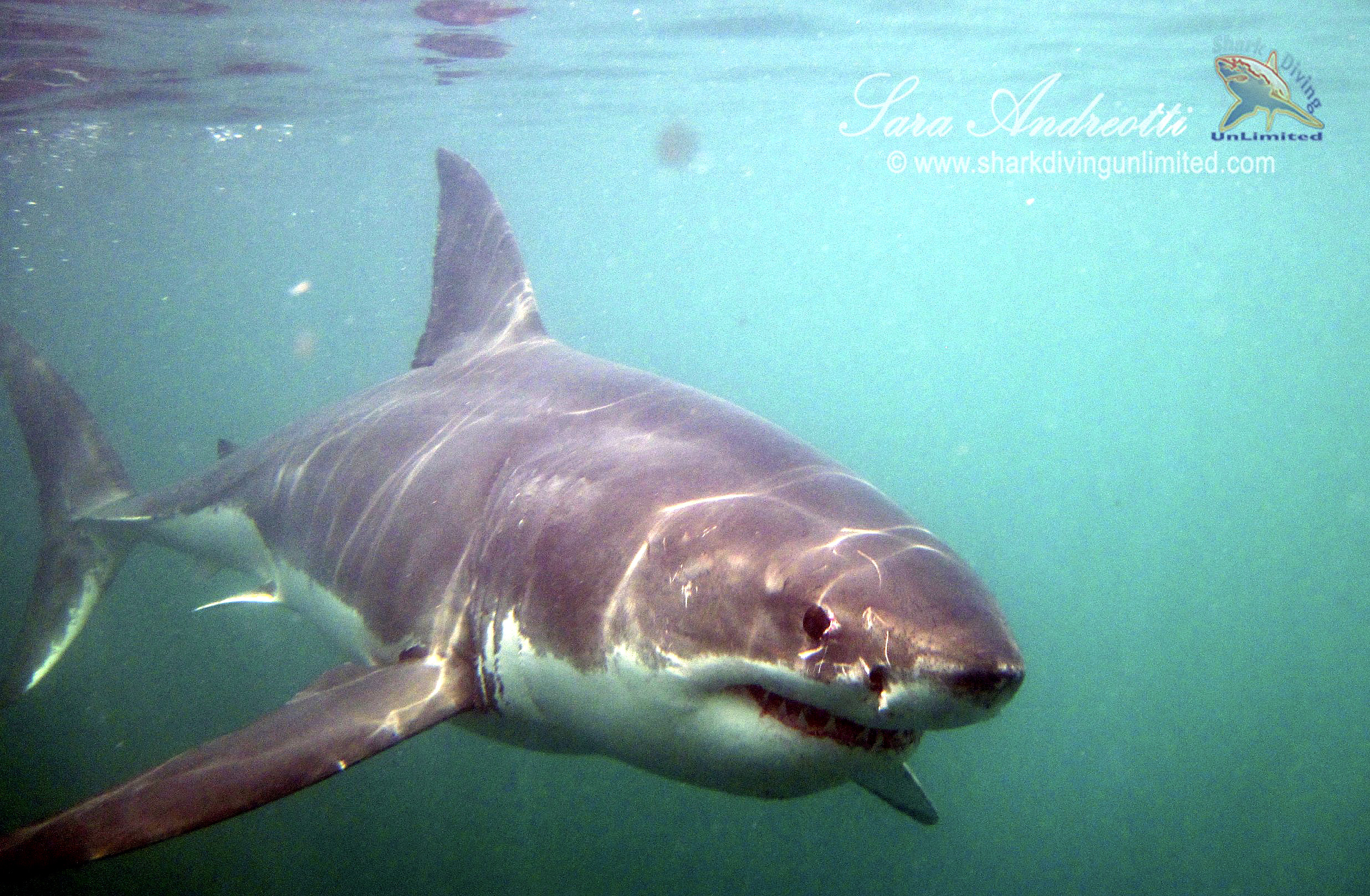
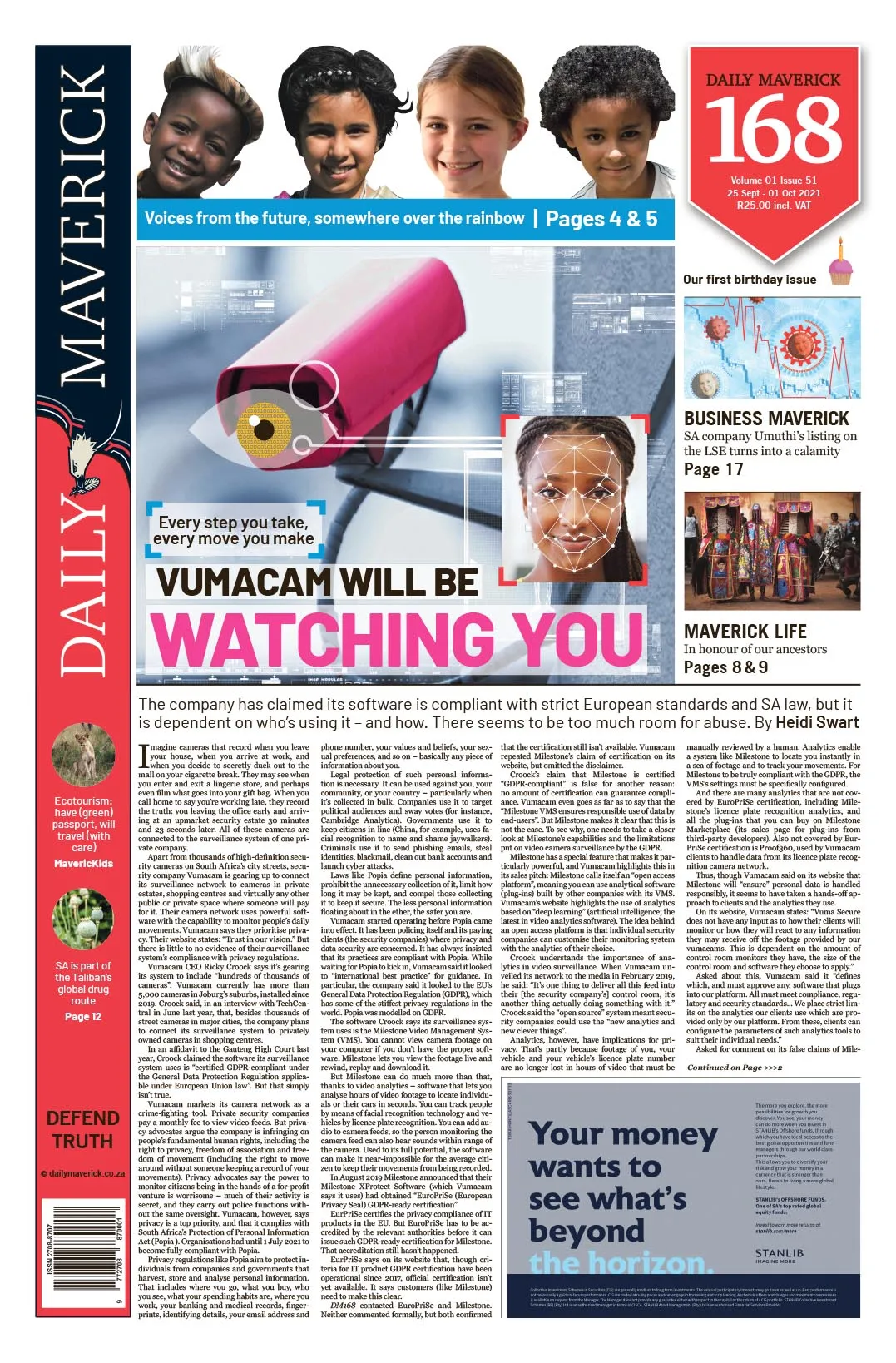



















 Become an Insider
Become an Insider
If you read the history of the HMS Birkenhead which sank off Danger Point 26 February 1852. In reports of those who survived, the water was said to be teaming with sharks. “An unfortunate number of victims suffered the gruesome fate of being torn apart and devoured by sharks. Lt. J.F. Girardot of the 43rd Light Infantry Regiment observed that the sharks appeared to target naked people”.
Although the sharks were not identified, it could reasonably be assumed that they were probably GW.
I grew up (1938 till about 1961) in Glencairn, between Fish Hoek and Simonstown, and was a keen bodysurfer (no sign of boards, other than the fairly short wooden ones with a turned up front, which we scorned), and none of us even gave a thought to the possibility of sharks in the area (or whales, for that matter). As far as we were concerned, sharks were to be found way up the Natal coast.